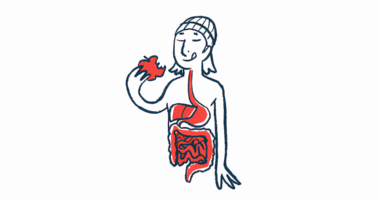Akathisia and Constipation: The Odd Couple

Sometimes, the call of nature is a daily dash to the bathroom. At least it used to be for me. I had a regular routine — until Parkinson’s disease came along.
Now, I don’t sense “having to go” in the same way. Days will go by without a visit to the white throne. Things get backed up worse than the LA freeway at rush hour, which gets quite uncomfortable.
I’m talking about constipation.
For those with a more sensitive nature, you can stop reading here. But I encourage you to continue, as I’ll explain how the symptoms of akathisia and constipation might be partners.
Sometimes, when not sensing the bowels moving, the rest of my body experiences the dance of akathisia, or muscle urgency. The urgency to move is such that I get out of bed and walk around at 4 a.m. to alleviate the muscles’ demand for action.
At this point, I don’t realize that some nerves are telling me to head to the bathroom. It doesn’t feel like my gut nerves are speaking out, telling me to go. But upon settling on the porcelain ship, it becomes apparent that the bathroom was the ultimate destination after all. Interestingly, the urge to move my external body goes away after completion of the bathroom task.
Constipation has long been associated with Parkinson’s and is one of the most frequent nonmotor symptoms. One study noted that up to 80% of Parkinson’s patients suffer from constipation. The phenomenon I find curious is the occasional pairing of akathisia and constipation.
A 1987 study in the journal Neurology, “Akathisia in idiopathic Parkinson’s disease,” noted that 26% of Parkinson’s patients could not explain the inability to remain still, a state of true akathisia. This disputes the common belief that akathisia simply represents the need to move for relief of discomfort imposed by rigidity or lack of movement.
It is also an injustice to label the experience as restlessness with the not-so-subtle “it’s all in your head, pull yourself out of it” comments. Other than drug-induced akathisia, this doesn’t explain the need to move when constipation is at play.
In my case, the constipation might be due to inhibition of body signals that normally indicate a bowel movement is imminent. At the same time, there are some excitation neural signals happening so that I experience akathisia. This combination is significant as an example of the pairing of excited signals (akathisia) with inhibited signals (constipation). This malfunctioning crossover inhibition pairing (MCIP) happens with enough regularity to be both repeatable and observable.
Recent research is starting to explore excitation/inhibition (E/I) mechanisms. The disruption of E/I has been implicated in many neurological diseases, including Parkinson’s. Think of the E/I mechanism as having two dials. One turns up the level for paying attention (E). The other turns down the input (I). These two affect all brain activity.
The wake-sleep cycle is an example of this. Researchers have identified the role of homeostatic and circadian processes in the wake-sleep cycle in primary neurological disorders such as Parkinson’s and Alzheimer’s diseases. Pain or facing danger can cause MCIP, an excited focus on the danger accompanied by brain blindness to anything else in the environment.
I have numerous malfunctions in my neural networks where excitation and inhibition are faulty, like when my early sleep cycle initiates akathisia and with my broken biological clock. As my Parkinson’s progresses, constipation/akathisia MCIP has moved up the rankings in my troublesome symptom list.
Given all of this, I propose that:
- My constipation is the result of inhibitory neural pathways that are well known in Parkinson’s.
- Akathisia is also a well-known event in Parkinson’s and may be a result of excitable neurons acting out at inappropriate and unguarded moments.
- The human brain simultaneously sends out inhibition and excitation signals. This can best be demonstrated during fight-or-flight responses, when parts of the brain are both excited and inhibited. Inhibition with constipation and excitation with akathisia may be acting in tandem due to faulty regulatory system processes. These rely on the E/I mechanism to regulate and return to homeostasis.
- With Parkinson’s, the E/I mechanism is broken and sometimes sends exaggerated excitation and inhibition signals simultaneously, which manifests as MCIP. The result is an odd pairing of observable phenomena — in my case, constipation paired with akathisia.
Given the individualized nature of this illness, it is likely that there will be a wide variety of these odd MCIP pairings. What have you observed as unusual, paired phenomena? Please share in the comments below.
Note: Parkinson’s News Today is strictly a news and information website about the disease. It does not provide medical advice, diagnosis, or treatment. This content is not intended to be a substitute for professional medical advice, diagnosis, or treatment. Always seek the advice of your physician or another qualified health provider with any questions you may have regarding a medical condition. Never disregard professional medical advice or delay in seeking it because of something you have read on this website. The opinions expressed in this column are not those of Parkinson’s News Today or its parent company, Bionews, and are intended to spark discussion about issues pertaining to Parkinson’s disease.








BARRY BLOCK
What is your recommended regimen for preventing constipation?
susan shulman
sounds like my husband. He when prone he gets the signal that he must go immediately, but bowel movement or even urination takes its time.
Paul
Dr C, you and I were diagnosed at approximately the same time. When I was first diagnosed, like most people early-on in their Parkinson's journey I was prescribed dopamine agonists. When the DAs would wear off, or if I inadvertently ran out, I would suffer horrible nighttime akathisia. There were nights I would get zero minutes of sleep because each time my body relaxed enough to transition to sleep, my body would experience an extremely strong urge to move. I could not get into a horizontal position for more than five minutes without an inescapable need to move. After some research, I learned I was suffering from dopamine agonist withdrawal syndrome (DAWS). It took several months to ween myself completely from dopamine agonists. Once the dopamine agonists were out of my system, the akathisia stopped and never returned.
It's something to look into.
Bill Roberts
I was diagnosed with PD in 2011 and I am now 85 years old - I'm still "Getting Around" very well, with some hesitation in my first steps and some Balance issues. I do stay active and busy, both "Physically and Mentally". I participate in the Oklahoma Parkinson's "Speak Out/ Loud Crowd" group. Constipation was an issue with me earlier, but with the advice of my PD Doctors, I resolved my the problem with "Miralax"(One Dose Daily) and fresh fruit, whole grain cereal, a minimum of "Red Meat". I sometimes take a full dose of the Miralax and can vary the dosage as needed if things get, "Too Loose" Although I am under the care of my Urologist, Urination is a much greater issue for me. When the urge occurs, I just don't make it to the bath room some time without the original "dribble". My current medications for the above issues are "Rytary" for Parkinson's, "Myrbetriq" for Bladder, and "Miralax" for Constipation. After eleven years of dealing with Parkinson's myself, I hope of my experience's will be of some benefit to others. Bill
JBrad
One very helpful food for the gut issues in PD is Yogurt and kefir--they help overcome my dyskinesia and regulate my digestive system, even when motility function is decreased. New studies support this; well worth a try.
richard norwood
I have PD and suffer from episodes of constipation weekly...asking if anyone has some remedies they can recommend...also have insomnia that is getting worse as the disease advances...the less I sleep the worse I get...I also have symptoms of LBD...changes in body temperature and pulse...anyone else experiencing this?
Sanjay KUMAR gupta
The article on constipation among parkinson patients is very nice and explains the plight of patients carrying `constipation' 24 hrs, with them but it would have been great if some remedial mesaures without intake of any medicines would have suggested so that people at large would have benefited. I am also in the same boat and some of own experienced measueres for relief from constipation: 1.Fruit Guvava daily about 200 gms. 2. Fruit Papaya Daily 200 gms
and still if no relief take 2 Tea spoonful of roasted and grinded Flakesseeds, you will defintely find it better.
Thanks and due regards to learned writer.
Pamela Martin
Both my brother and my husband were diagnosed with Parkinson's although they presented in different ways. My brother recently died recently due to constipation which ended up causing a blockage and perforation of the bowels. My husband on the other hand has no trouble at all with constipation. He's more regular than I am and I don't have PD.
Daniel Novak
Dr. C,
I also picture the E/I battle when I think about dyskinesia. Movement slow = take more = movement continous = take less. And movement slow in one area = take more = movement everywhere = whoa too much.
Regarding constipation, is there a motility issue at play? It seems as if there is 'nothing in waiting' fpr several days and then a slow parade that made the journey.
Mike
I have had Parkinson’s ‘officially’ since 10/2020. Probably several years longer. To avoid constipation I take Wal-lax daily. I also eat a lot of berries blue, raspberry and blackberries. I live in Arizona and these berries go on sale for 89 cents a 1/2 pint no limit periodically. When they go on sale I fill up my freezer. With a steady diet of berries and laxative daily I stay ‘unplugged’.
I don’t seem to suffer from Akathisia much. Maybe that is because of my regularity. Your articles are great because they get me thinking about my condition in ways that I would not otherwise. Thanks again, Blessings, Mike
JJ Smith
I have my husband use wheat bran for his constipation and it's been working well.
John D Kirkman
I did not suffer from constipation to start with but is beginning to be a problem now. I will use some of the suggestions in this forum if needed.
John Citron
Both my primary care doctor and my neurologist/MDS-specialist thinks it's due to motility. The muscles in the intestines and bowel don't move as much or as quickly as they used to so the stuff remains.
In my own system, the plumbing is messed up to put it nicely. I will have a good "passing" one day and figuratively do a happy dance. This will be followed by less and less over the next few days to finally nothing for quite a number of days.
During the nothing days, I don't even have gas or the urge to go. There's no sensation of urgency or anything. This period can last for quite number of days which makes me a little desperate. Taking laxatives or stimulants for this, doesn't make a hill of beans of difference and the stimulants only make me painfully gassy.
Jo S.
It's a shame that more comments didn't address your question of paired phenomena and focused mainly on sharing their solutions for constipation (which wasn't the topic).
Like you, I suffer from akathisia and constipation. These are my two worst and least manageable symptoms. (Please, folks, don't share your constipation solutions with me. I've already tried them all.) I haven't noticed a connection between needing to "sit on the throne" and my akathisia episodes, but I'll certainly pay more attention to that just in case I'm missing something. I haven't actually noticed any other phenomena associated with the akathisia at all. It is very random, but it primarily occurs in the early evening or at night. Recently, I even woke up in the middle of the night with an "episode." I'd love to hear from more PWP who experience akathisia, as it seems to be a symptom that is under-discussed.
David N.
Jo S.
I can relate to your issues with constipation and akathisia. I take Miralax for the constipation and my doctor believes the that the akathisia is a result of wearing off. This is most likely the problem, but I’m still in a phase trying to correct it. I take Rytary through out the day. Akathisia does have a tendency to appear when I’m close to my next dose. It also seems to really rear its ugly head after I go to bed and I am almost asleep. I have woken up in the middle of the night with this problem. Sometimes it is just one leg or all four limbs. I refer to it as restless body. I can resist moving, but I still feel it in the effected limb(s) that I should move it/them. I agree, these are my two worst symptoms.
Dr. C.
Hi Jo ~ Thank you for recognizing the point of the column. Akathisia is very obvious in PD. My akathisia is also at night. It seems to be an understudied, and I'm finding it is associated with urinary urgency. I realize it is difficult to sort all the body parts out but discovering the association between akathisia and other regulatory dysfunctions requires time in insight meditation. I look forward to hearing if you discover anything further and share with the community.
Dr. C.